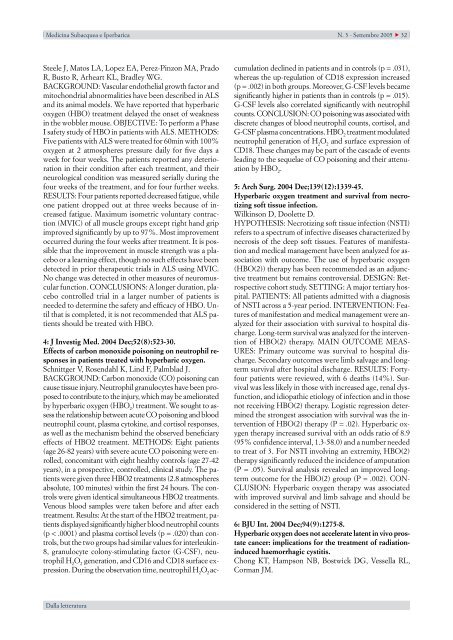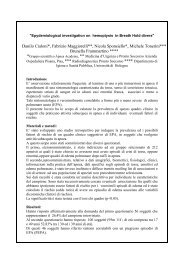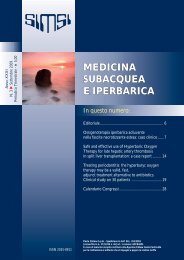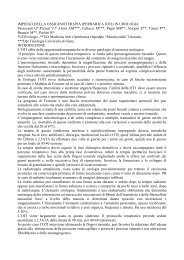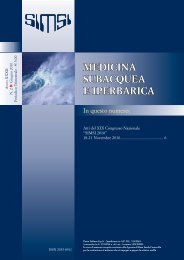Numero 3 - simsi
Numero 3 - simsi
Numero 3 - simsi
You also want an ePaper? Increase the reach of your titles
YUMPU automatically turns print PDFs into web optimized ePapers that Google loves.
Medicina Subacquea e Iperbarica N. 3 - Settembre 2005 32<br />
Steele J, Matos LA, Lopez EA, Perez-Pinzon MA, Prado<br />
R, Busto R, Arheart KL, Bradley WG.<br />
BACKGROUND: Vascular endothelial growth factor and<br />
mitochondrial abnormalities have been described in ALS<br />
and its animal models. We have reported that hyperbaric<br />
oxygen (HBO) treatment delayed the onset of weakness<br />
in the wobbler mouse. OBJECTIVE: To perform a Phase<br />
I safety study of HBO in patients with ALS. METHODS:<br />
Five patients with ALS were treated for 60min with 100%<br />
oxygen at 2 atmospheres pressure daily for five days a<br />
week for four weeks. The patients reported any deterioration<br />
in their condition after each treatment, and their<br />
neurological condition was measured serially during the<br />
four weeks of the treatment, and for four further weeks.<br />
RESULTS: Four patients reported decreased fatigue, while<br />
one patient dropped out at three weeks because of increased<br />
fatigue. Maximum isometric voluntary contraction<br />
(MVIC) of all muscle groups except right hand grip<br />
improved significantly by up to 97%. Most improvement<br />
occurred during the four weeks after treatment. It is possible<br />
that the improvement in muscle strength was a placebo<br />
or a learning effect, though no such effects have been<br />
detected in prior therapeutic trials in ALS using MVIC.<br />
No change was detected in other measures of neuromuscular<br />
function. CONCLUSIONS: A longer duration, placebo<br />
controlled trial in a larger number of patients is<br />
needed to determine the safety and efficacy of HBO. Until<br />
that is completed, it is not recommended that ALS patients<br />
should be treated with HBO.<br />
4: J Investig Med. 2004 Dec;52(8):523-30.<br />
Effects of carbon monoxide poisoning on neutrophil responses<br />
in patients treated with hyperbaric oxygen.<br />
Schnittger V, Rosendahl K, Lind F, Palmblad J.<br />
BACKGROUND: Carbon monoxide (CO) poisoning can<br />
cause tissue injury. Neutrophil granulocytes have been proposed<br />
to contribute to the injury, which may be ameliorated<br />
by hyperbaric oxygen (HBO 2 ) treatment. We sought to assess<br />
the relationship between acute CO poisoning and blood<br />
neutrophil count, plasma cytokine, and cortisol responses,<br />
as well as the mechanism behind the observed beneficiary<br />
effects of HBO2 treatment. METHODS: Eight patients<br />
(age 26-82 years) with severe acute CO poisoning were enrolled,<br />
concomitant with eight healthy controls (age 27-42<br />
years), in a prospective, controlled, clinical study. The patients<br />
were given three HBO2 treatments (2.8 atmospheres<br />
absolute, 100 minutes) within the first 24 hours. The controls<br />
were given identical simultaneous HBO2 treatments.<br />
Venous blood samples were taken before and after each<br />
treatment. Results: At the start of the HBO2 treatment, patients<br />
displayed significantly higher blood neutrophil counts<br />
(p < .0001) and plasma cortisol levels (p = .020) than controls,<br />
but the two groups had similar values for interleukin-<br />
8, granulocyte colony-stimulating factor (G-CSF), neutrophil<br />
H 2 O 2 generation, and CD16 and CD18 surface expression.<br />
During the observation time, neutrophil H 2 O 2 ac-<br />
Dalla letteratura<br />
cumulation declined in patients and in controls (p = .031),<br />
whereas the up-regulation of CD18 expression increased<br />
(p = .002) in both groups. Moreover, G-CSF levels became<br />
significantly higher in patients than in controls (p = .015).<br />
G-CSF levels also correlated significantly with neutrophil<br />
counts. CONCLUSION: CO poisoning was associated with<br />
discrete changes of blood neutrophil counts, cortisol, and<br />
G-CSF plasma concentrations. HBO 2 treatment modulated<br />
neutrophil generation of H 2 O 2 and surface expression of<br />
CD18. These changes may be part of the cascade of events<br />
leading to the sequelae of CO poisoning and their attenuation<br />
by HBO 2 .<br />
5: Arch Surg. 2004 Dec;139(12):1339-45.<br />
Hyperbaric oxygen treatment and survival from necrotizing<br />
soft tissue infection.<br />
Wilkinson D, Doolette D.<br />
HYPOTHESIS: Necrotizing soft tissue infection (NSTI)<br />
refers to a spectrum of infective diseases characterized by<br />
necrosis of the deep soft tissues. Features of manifestation<br />
and medical management have been analyzed for association<br />
with outcome. The use of hyperbaric oxygen<br />
(HBO(2)) therapy has been recommended as an adjunctive<br />
treatment but remains controversial. DESIGN: Retrospective<br />
cohort study. SETTING: A major tertiary hospital.<br />
PATIENTS: All patients admitted with a diagnosis<br />
of NSTI across a 5-year period. INTERVENTION: Features<br />
of manifestation and medical management were analyzed<br />
for their association with survival to hospital discharge.<br />
Long-term survival was analyzed for the intervention<br />
of HBO(2) therapy. MAIN OUTCOME MEAS-<br />
URES: Primary outcome was survival to hospital discharge.<br />
Secondary outcomes were limb salvage and longterm<br />
survival after hospital discharge. RESULTS: Fortyfour<br />
patients were reviewed, with 6 deaths (14%). Survival<br />
was less likely in those with increased age, renal dysfunction,<br />
and idiopathic etiology of infection and in those<br />
not receiving HBO(2) therapy. Logistic regression determined<br />
the strongest association with survival was the intervention<br />
of HBO(2) therapy (P = .02). Hyperbaric oxygen<br />
therapy increased survival with an odds ratio of 8.9<br />
(95% confidence interval, 1.3-58.0) and a number needed<br />
to treat of 3. For NSTI involving an extremity, HBO(2)<br />
therapy significantly reduced the incidence of amputation<br />
(P = .05). Survival analysis revealed an improved longterm<br />
outcome for the HBO(2) group (P = .002). CON-<br />
CLUSION: Hyperbaric oxygen therapy was associated<br />
with improved survival and limb salvage and should be<br />
considered in the setting of NSTI.<br />
6: BJU Int. 2004 Dec;94(9):1275-8.<br />
Hyperbaric oxygen does not accelerate latent in vivo prostate<br />
cancer: implications for the treatment of radiationinduced<br />
haemorrhagic cystitis.<br />
Chong KT, Hampson NB, Bostwick DG, Vessella RL,<br />
Corman JM.


